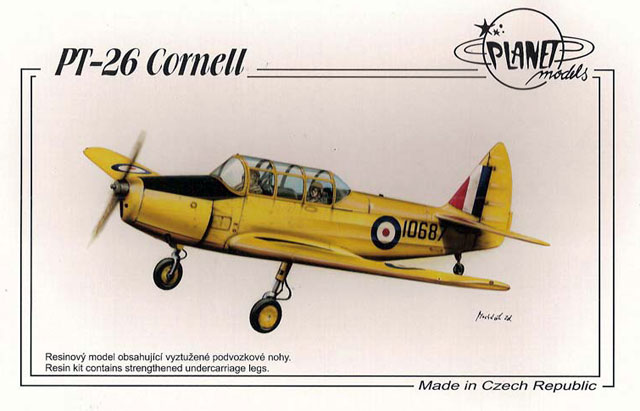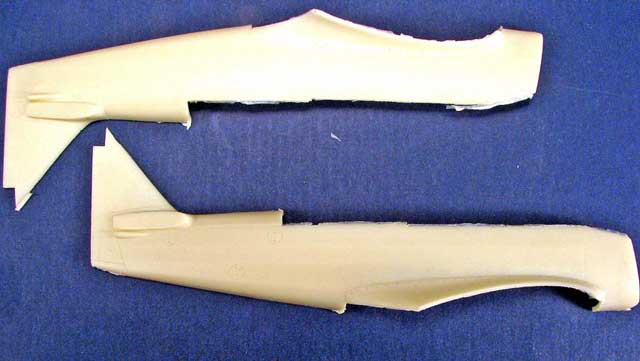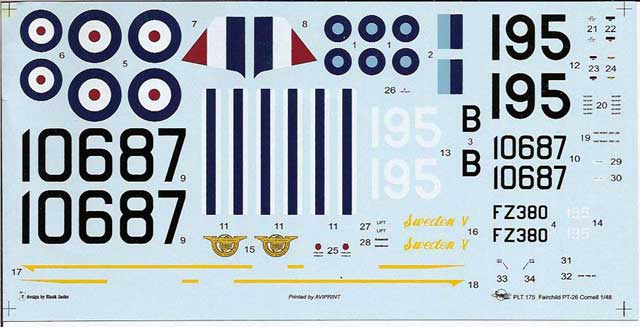|
Fairchild P-26 Cornell

Planet Models, 1/48
S
u m m a r y
|
| Catalogue Number: |
175 -
Fairchild P-26 Cornell |
| Scale: |
1/48 |
| Contents and Media: |
34 pieces in
cream colored resin, three in a white molded material and two clear vac-form
canopies. Instructions, painting guide and decal sheet for 3 aircraft. |
| Price: |
USD $53.96. Available from Squadron Mail Order.
|
| Review Type: |
FirstLook - In Box |
| Advantages: |
Finely
engraved panel lines, well molded small part detail, and seemingly
excellent fit. |
| Disadvantages: |
Poorly formed
wing hand holds, delicate parts in resin. Requires use of cyanoacrylic
(super / crazy) glue and /or two-part epoxy. |
| Recommendation: |
Highly recommended for modelers who
have experience with resin kits and parts. |
Reviewed by Steven "Modeldad" Eisenman

Planet Models' 1/48 scale Fairchild P-26 Cornell is
available online from
Squadron
The PT-26 was the last in the line of Fairchild
primary trainers, and was built specifically for the Royal Canadian Air
Force, designated the Cornell, it was built both by Fairchild under
lend-lease and Fleet Aircraft Ltd of Canada. It had a fully enclosed
dual cockpit with cockpit heating; both of which were needed for service
in Canada.
Some Cornells were transferred on and served with
the RAF and the Royal Norwegian Air Force at “Little Norway” in Canada.
While a number of restored PT-26’s are shown in USAAF markings, it is
not clear if, in fact, the USAAF actually operated this aircraft.
Planet Models has, once again, produced very nice
little resin kit. The detail is finely engraved and the fabric effect
on the fuselage is delicately done. Pictures of Fairchild trainers in
flight show the fabric tight against the fuselage stringers. But, the
kit’s presentation represents it well when not in flight.
A quick test fit show that the parts fit well and
only a little filler may be needed on top at the wing to fuselage join.
There is only a thin edge butt join of the cowling to the fuselage, so
care will be needed in test fitting. Slow cure CA glue is recommend for
this. Actually, slow set CA would be best for joining all the major
components in this kit.

Click
the thumbnails below to view larger images:
The kit does show the limitations of
resin molding. Planet Models attempted to mold the hand holds at the
trailing edge of the wing tip. But, the result is that it looks as if
someone took a small bite out of the edge. You could try closing up the
gap using a strand of glue or a fine shaving of resin.
Being a trainer, and a small resin kit, the cockpit is a little sparse.
But other than the instrument panels and control sticks, there probably
was not much in there anyway. Some dry brushing will help to bring out
the sidewall framing.
I do not have much to go on in determining the accuracy of this kit.
But, the wingspan of the PT-26 Cornell is said to be 36 feet, while the
kit’s wings measure about four scale inches short of that.
The landing gear in the kit seems to be molded in something that appears
to be neither resin nor plastic. It is white in color. However, I was
unwilling to bend the gear to test its strength.
Markings
The decals appear to be well printed by AVIPRINT. Even though the RAF
Type A roundels are printed as one piece, the red center is in fairly
good register. The decals include a number of stencils.

Click
the thumbnails below to view larger images:
Royal Air Force; 31st EFTS, De Winton Air Base, Alberta, Canada. Serial
Number 10687. This aircraft, amongst others, was used by
Czechoslovakian instructors and students. The aircraft is in over-all
Trainer Yellow. The type A roundel is in six positions, along with a
fin flash of equal proportions.
Indian Air Force; 2. EFTS, Jodhpur, India, 1944. This aircraft is in
over-all Silver. The markings are the light and dark blue SEAC roundel
and fin flash. The serial number is FZ380
Royal Norwegian Air Force; “Little Norway”, Canada. This aircraft
appears to be in the USAAF Light Blue #23 fuselage with Yellow #4
wings. The serial number is 195 and the name “Sweden V” appears on both
sides of the nose. In order to produce the Norwegian national markings
you will need to paint red bands on the wings and the rudder, upon which
you apply the kit’s white/blue/white decal stripe. There is a crest on
the side that indicates that the Sweden-America Club bought the aircraft
for the RNAF. (No FS numbers are given for Lt. Blue 23 and Yellow 4.
Dana Bell indicates that for Lt. Blue 23, FS35109 is a poor match, as 23
was stronger, a little greener, a little lighter and glossy. For Yellow
4, Dana indicates FS13432, but that 4 was darker, more yellow and weaker
- Air Force Colors Vol. I, published by Squadron/Signal)
I am sure many modelers may be put off by the price
of this little kit. But in making one’s decision, one must keep in mind
the absence of models of trainer aircraft in 1/48 scale and the fact
that this is a resin kit. Also, regardless of the scheme you choose,
this will stand out as a little gem in any collection, especially if you
go with the RNAF scheme.
Resin kits just seem to be getting better and
better, and this kit is no exception. All things considered, I highly
recommend it.
Highly Recommended.
Thanks to MPM / Planet Models for the review sample.
MPM
and Planet Model
kits are available worldwide through hobby retailers
worldwide
and at
Squadron.com
Review and Images Copyright © 2006 by
Steven Eisenman
Page Created 20 June, 2006
Last updated 19 June, 2006
Back to HyperScale Main Page
Back to Reviews Page
|
Home | What's
New | Features
| Gallery |
Reviews | Reference
| Forum
| Search